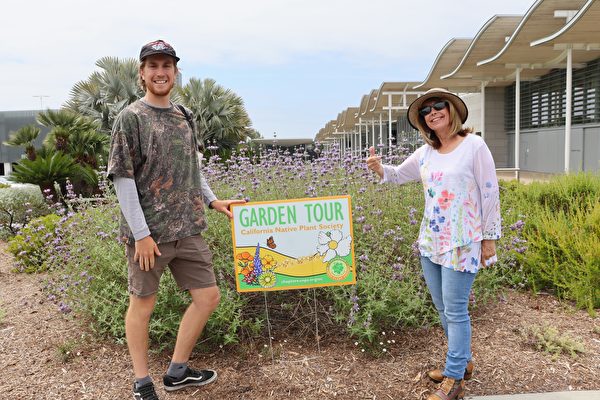On May 4th (last Saturday), the Orange County chapter of the California Native Plant Society held the 22nd annual Tour of Garden event, introducing residents to 13 public and open private gardens in South Orange County where they could explore and appreciate native plants.
The theme for this year was “California in my Garden.” Public and private gardens in North Orange County were also open to residents on May 5th, with the association providing self-driving route maps for visitors. The California Native Plant Society has a total of 36 chapters, each with its own garden tour routes and schedules.
Volunteers of the Orange County Native Plant Society, like Charlie Gibbons who is responsible for the landscape beautification with native plants, mentioned that the association is a statewide non-profit organization. Gibbons stated, “In Orange County, we conduct botanical research, host lectures, and garden tour events to engage more people in protecting native plants.”
With around 700 volunteers in the Orange County Native Plant Society and an estimated 15,000 across California, the Garden Tour aimed to educate residents on incorporating native plants into their gardens. Gibbons emphasized, “Plants are the foundation of the ecological cycle, native plants attract birds, butterflies, bees, and insects.” The state’s population growth and urban development have led to the loss of many native habitats for plants and animals in California, making restoration efforts challenging and costly once lost.
Some cities emphasize the ecological environment of native plants, with the first stop on the tour route being the Newport Beach Civic Center. The sculpture garden beside the civic center retained native plants growing within a 100-mile range (including coastal islands and deserts), categorized into Coastal Sage Scrub, Chaparral/Grassland, Wetland, and desert plant communities (originating outside Orange County). Gibbons noted that Costa Mesa and Cypress also planted many native plants.
Stacy Kramer, a volunteer of the association and a biologist, expressed, “Native plants are incredibly beautiful and enchanting. Without understanding their ecosystem, people won’t care for or protect them.” She added, “If not protected and lost, our future generations will never get to see them.”
Kramer, fond of outdoor activities and fascinated by the complexity and diversity of plant life, joined the association after retirement. “We’ve visited different mountain areas to search for native plants and clear out invasive species, so that native plants won’t be overrun and taken over by invasive species,” she explained.
Orange County boasts significant natural reserves, with the Irvine Company donating 57,500 acres of land as permanent open space. “When you observe nature in Orange County, you’ll discover amazing and beautiful species. Planting them in your yard is just awesome,” remarked Gibbons. Many people worry about droughts and water usage, but native plants are drought-resistant and self-sustaining.
Irina Ensminger’s yard underwent a transformation in 2020. Her daughter mentioned that during the pandemic, her mother aimed to renovate the garden. Initially considering a Mediterranean style, Irina was inspired by native plant gardens after research, especially when water conservation was on people’s minds.
Ensminger showcased photos of the yard before and during the transformation process. Why do many native plant flowers appear small? She explained that it’s because they adapt to California’s environment, suitable for hummingbirds; some tender leaves are green initially and gradually turn white to reduce sunlight absorption. After the renovation, her garden became a haven for hummingbirds, bees, and lizards.
Planting in various areas of the garden with different blooming seasons and colors, Ensminger grew California Poppies in two hues, attracted hummingbirds with the red Island Bush Monkeyflower, and showcased the blue-white Baby Blue Eye.
Even Lupines sprouted in gravel and empty land. Are native plants mutually attractive? “I didn’t plant those, probably brought by birds,” Ensminger remarked.
Kathryn McCleland welcomed over 150 residents to her garden. Moving to her current residence in 2015, the backyard sat on a hill. They cleared the existing plants, now featuring 75% native plants alongside fruit trees and some vegetables. Apart from attracting hummingbirds and other beautiful birds, even eagles visited. She shared, “There are two bird nests in the yard, one right on the roof eaves of the wild grapevine trellis, a very safe spot, and wild grapes are also a favorite food for the birds.”
McCleland highlighted that everyone can design their favorite garden. “I plant a little bit of plants in different locations, giving them room to grow,” she said. Starting with seeds or small seedlings doesn’t require much money; “water and care are needed for the first three years, afterward, they thrive on their own without fertilization, drawing everything they need from the soil, growing excellently.”
Jeff Bohn cultivated over 90 species of native plants in his yard: the front planted with Northern California natives, and the back enjoying better sunshine with Southern California natives. “My wife loves flowers a lot,” he chuckled.
Residents Flo Niermon and Constance Husted attended together, both participating for the first time. Husted shared that she learned a lot about native plants, while Niermon was eager to renovate her small front garden.
How can people identify and locate California native plants? Gibbons suggested checking out www.calscape.org, a website listing nearly 8,000 species of native plants. Using a plant identifying app on your phone is another option, along with visiting the Tree of Life Nursery in San Juan Capistrano in Southern Orange County, offering over 500 native plant varieties. The best planting season generally falls between winter and spring.

